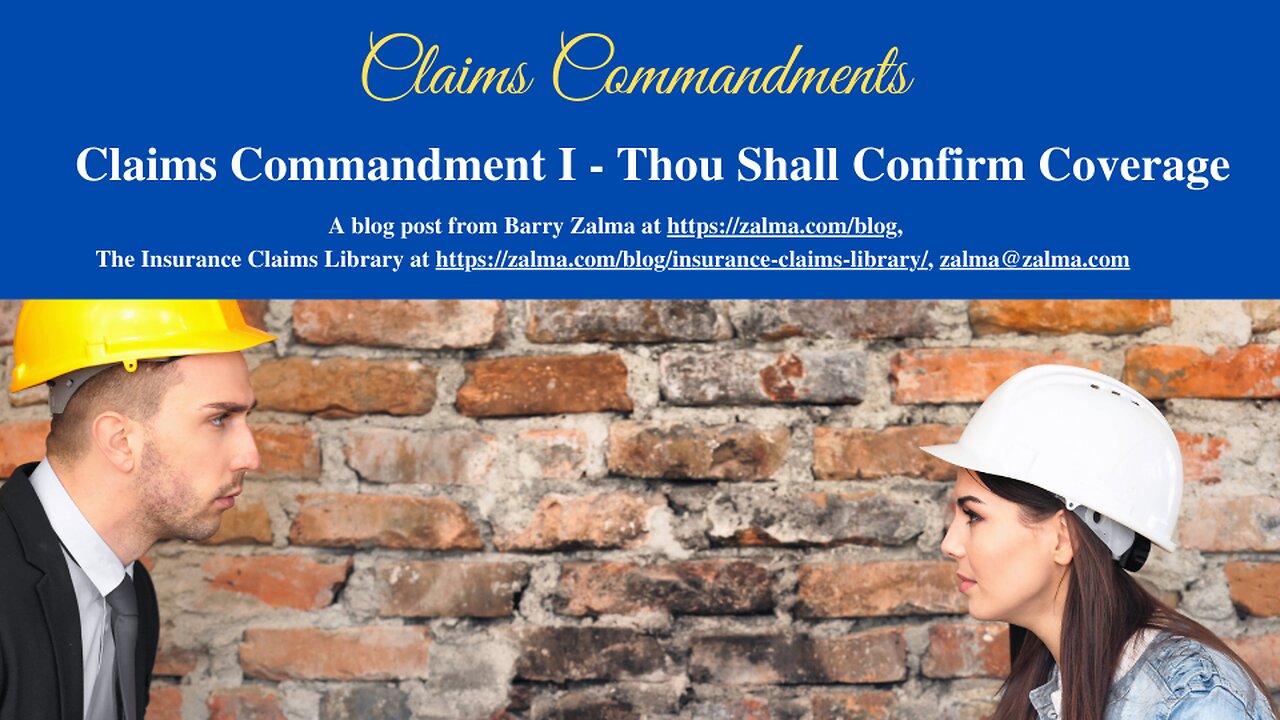Premium Only Content

Claims Commandments
Claims Commandment I - Thou Shall Confirm Coverage
When I was a young adjuster, I worked for the Fireman’s Fund Insurance Company. Occasionally confused insureds and brokers would report to the Fireman’s Fund a claim meant for Fireman’s Insurance of Newark. The claim would often be adjusted and paid before anyone realized an error had been made.
Notice provisions in insurance policies serve the important function of allowing the insurer the opportunity to make a timely and thorough investigation of the insured’s claim. American States Insurance Co. v. National Cycle, 260 Ill. App. 3d 299, 310-11, 631 N.E.2d 1292, 197 Ill. Dec. 833 (1994); Twin City Fire Insurance Co., 266 Ill. App. 3d at 7.
When a loss or claim is reported to an insurance company the first task required of the insurer and its claim personnel is to confirm the existence of a policy. The task today is much simpler than it was when I was an adjuster where we had to pull out the actual underwriting file and review the daily report. Now, coverage can be confirmed by computer.
If the insurer’s computer system shows that a policy was in effect at the time the insured reported that a loss occurred, the first step of confirming coverage was completed. Next, if available digitally, the entire policy must be accessed including the declarations page and all policy wordings, all endorsements and modifications to the standard policy language.
The claims person needs to have available a specimen of the policy as it would have been delivered to the insured so that the claims person can be read, review and understand the promises made by the policy to enable the claims person to explain the available coverages to the person(s) insured.
If the entire policy is not available electronically or cannot be recreated by the underwriting department the agent or broker should be asked to provide a complete copy of the policy to the adjuster. If the agent or broker does not have it a copy should be obtained from the insured. Modern insurers now deliver policies to their insured’s electronically in Adobe .pdf format which can be attached to an email from the insured at the request of the claims person.
Once the policy is obtained and available for review the claims person must read and understand the policy coverages and compare those to the wording of the policy to confirm that one of the policy coverages promises to indemnify the insured against the risk of loss of the type reported.
For example:
If the policy is a property policy that insures the insured against the risk of loss of a dwelling by fire, lightning, windstorm and hail, and nothing more and the insured reports a claim for damage caused by earthquake the existence of a policy is confirmed but the existence of coverage is not.
If the policy is a liability policy like a Commercial General Liability (CGL) policy and the insured reports that the mailman was bitten by the insured’s pit bull terrier during the policy period, coverage is confirmed. However, if the policy contains an exclusion for losses caused by dog bite or pit bulls, coverage is confirmed with a exclusion that might be applicable.
If the policy is a CGL and the insured reports, he was sued for slander by a business competitor during the policy period coverage is confirmed and there is available defense under the “Personal Injury” coverage part.
If a policy is a National Flood Insurance policy in effect at the time that a water main breaks and floods the insured’s house, coverage is confirmed that the policy exists, and a determination must be made to determine if the loss falls within the terms and conditions of the policy.
If a policy is a CGL and the insured reports he was sued for intentionally punching a business competitor in the nose, coverage is confirmed that the policy was in effect, but questions must be answered to determine if there is evidence that indicates there was no intentional act or that the insured was acting in self-defense, or some other nonintentional act.
What these examples show is that the existence of a policy can be confirmed, and it can be easily confirmed that it was in existence at the time of the loss. What cannot be established from the loss notice and policy wording is whether the coverage applies to the loss that was reported.
Communications with the Insured
Once coverage is confirmed the claims person must read the policy and the initial written contact with the insured should advise the insured all benefits, coverage, time limits, or other provisions of any insurance policy issued by that insurer that may apply to the claim presented by an insured.
The letter should include, as a bare minimum, information like the limits of liability of the policy, any deductibles or self-insured retentions, advice concerning any specific exclusions or conditions that may apply to the facts established by the notice of loss, a written notice that a proof of loss is required within 60-days of the letter with an attached proof of loss form, a requirement for the production of necessary documents, a reservation of rights (if called for because of a potential coverage problem like an exclusion that might apply), and any other information the insured needs to prove his, hers, or its claim.
The claims person should also be prepared to supplement the initial letter whenever he or she learns of different facts or additional coverages available to the policyholder or the insured.
Failure to properly, and in writing, advise the insured of the policy provisions, the requirement for documents, the problems with coverage based on the initial report of loss, can place a claims person inadvertently violating the state’s fair claims settlement practices statutes and regulations and expose the insurer to litigation for bad faith claims handling.
More Required
Confirmation of coverage requires more than simply checking a computer. It requires an understanding of the policy wording, the facts of the loss and the law of the jurisdiction to determine if coverage for a particular loss is available to the insured. Simply reading the loss notice, allegations in a lawsuit, and the policy is never enough.
The claim person’s first and foremost duty of is to confirm the existence of coverage whereby the insurer agreed to insure the person making a claim. It is a beginning of claims handling and cannot, on its own, fulfill the obligation to confirm coverage before the adjustment begins because the applicability of coverage can be affected by the claims investigation.
(c) 2022 Barry Zalma & ClaimSchool, Inc.
Barry Zalma, Esq., CFE, now limits his practice to service as an insurance consultant specializing in insurance coverage, insurance claims handling, insurance bad faith and insurance fraud almost equally for insurers and policyholders. He practiced law in California for more than 44 years as an insurance coverage and claims handling lawyer and more than 54 years in the insurance business. He is available at http://www.zalma.com and zalma@zalma.com.Subscribe and receive videos limited to subscribers of Excellence in Claims Handling at locals.com https://zalmaoninsurance.locals.com/subscribe.Subscribe to Excellence in Claims Handling at https://barryzalma.substack.com/welcome.
Write to Mr. Zalma at zalma@zalma.com; http://www.zalma.com; http://zalma.com/blog; daily articles are published at https://zalma.substack.com. Go to the podcast Zalma On Insurance at https://anchor.fm/barry-zalma; Follow Mr. Zalma on Twitter at https://twitter.com/bzalma; Go to Barry Zalma videos at Rumble.com at https://rumble.com/c/c-262921; Go to Barry Zalma on YouTube- https://www.youtube.com/channel/UCysiZklEtxZsSF9DfC0Expg; Go to the Insurance Claims Library – https://zalma.com/blog/insurance-claims-library
-
 8:57
8:57
Barry Zalma, Inc. on Insurance Law
1 year agoNo Coverage for Benefits no Right to Bad Faith Damages
201 -
 3:47:23
3:47:23
Nerdrotic
15 hours ago $35.09 earnedFantastic 4 HER! Daredevil BORE Again SUCKS! Disney Star Wars is DESPERATE | FNT Vegas 350
157K27 -
 5:21:14
5:21:14
MyronGainesX
1 day ago $26.33 earnedFormer Fed Explains FSU Shooting, Charlie Kirk vs Groyper Debate!
116K41 -
 1:03:22
1:03:22
IsaacButterfield
13 hours ago $4.66 earnedKaty Perry in Space?! Trans Women Law Controversy & Lizzo's Weight Loss Shocks Fans!
54.5K15 -
 6:15:39
6:15:39
Sm0k3m
10 hours agogaming night
51.6K1 -
 3:48:35
3:48:35
I_Came_With_Fire_Podcast
18 hours agoHOUTHIS & CHINA | MURDERER MERCH STORE | TRUMP SICK OF WAITING
55K9 -
 1:09:15
1:09:15
Keepslidin
8 hours ago $1.07 earnedIRL GAMBLING & GIVING PEOPLE MONEY WHEN THEY WIN
30.7K5 -
 6:10:30
6:10:30
Eternal_Spartan
19 hours agoLive at 9pm Central | Halo 3 & Halo Firefight! Come Hang out with a USMC Vet and join the best chat!
31.1K1 -
 4:06:20
4:06:20
VapinGamers
10 hours ago $1.81 earnedFortnite Friday - Game Night with the Family - !brian !rumbot
34.9K6 -
 59:22
59:22
Motherland Casino
8 hours ago $1.82 earnedScar x Ayanna
19K11